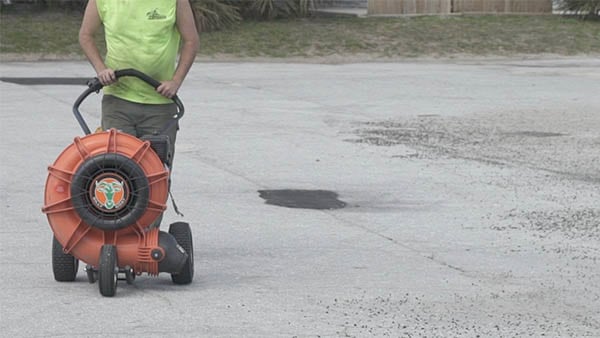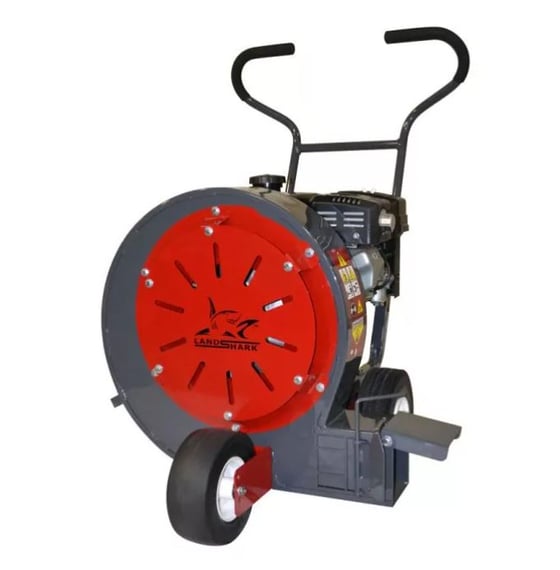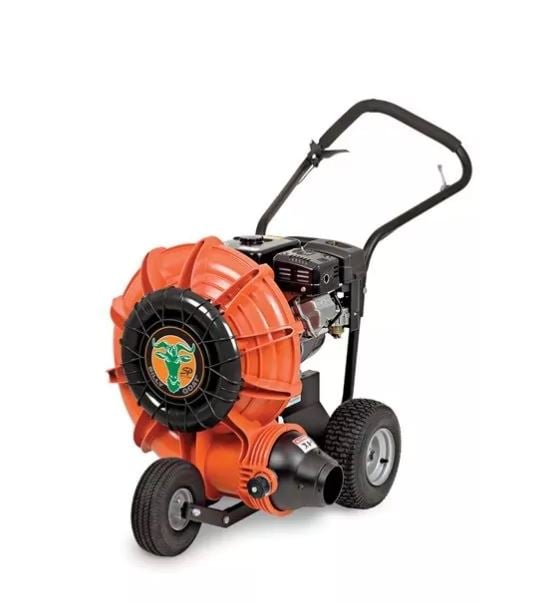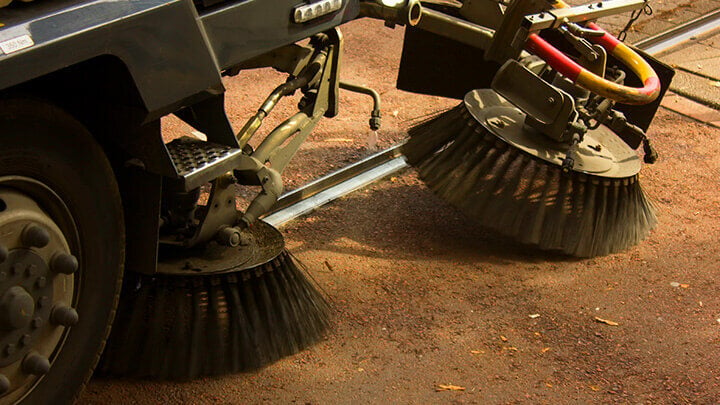- Gas blowers are essential tools for contractors prepping an asphalt driveway or parking lot for maintenance or repair.
- Backpack and walk-behind models are available for contractors.
- Regular maintenance and prompt repair are essential to getting the most out of your gas blower.
Prepping a huge parking lot for sealing or crack filling without the right tools is back-breaking and time-consuming. Sure, your ordinary push broom can get into those nooks and crannies. But if you're a busy asphalt maintenance contractor, a broom simply won't cut it. You need something that can help you finish surface prep as quickly as possible.
Enter the gas blower.
In this blog, you'll learn why the gas blower is the perfect surface prep tool and how a little TLC can extend its lifespan. And if you're in the market for a new one (you probably landed here because you're looking for gas blowers for sale), you'll also learn how to pick the right leaf blower. Let's get started.
Table of Contents
- Gas Blowers: An Introduction
- How Effective They Are in Cleaning Asphalt
- Versatility in Residential and Commercial Settings
- How to Maintain Your Leaf Blower
- Conquering Challenging Conditions During Asphalt Maintenance
- Using the Machine in Wet Conditions
- Frequently Asked Questions
What is a Gas Blower?
Gas blowers (more popularly known as leaf blowers) are used to remove dust, leaves, and other debris from asphalt, concrete, and other surfaces. More powerful models can also remove small pieces of gravel.
It is used to remove grass clippings, weeds, dried flowers, and other types of green waste. In some cases, it can also be used to remove light snow from cars and pavements.
These powerful gas blowers do more than just tidy up driveways and parking lots. They play an important role in ensuring the longevity and pristine appearance of driveways and parking lots.
By efficiently removing debris, gas powered leaf blowers ensure that moisture doesn’t become asphalt's silent destroyer. You see, a clean surface is less prone to water retention, and this reduces the risk of surface breakdown and potential potholes.
Gas leaf blowers also play a huge role in sealcoating and crack repair preparation. By removing leaves and dirt, contractors ensure that the asphalt sealant adheres to the surface properly.
Beyond the functional benefits, a debris-free asphalt surface just looks ten times better. Gas blowers help maintain a pavement's clean and polished appearance. They help enhance curb appeal and leave a positive impression on visitors or clients.
Related: Asphalt Surface Preparation Tools & Equipment
How Effective are Gas Blowers in Cleaning Asphalt?
 Using a walk-behind gas-powered leaf blower to clean a parking lot
Using a walk-behind gas-powered leaf blower to clean a parking lot
Gas blowers stand out as essential tools in asphalt maintenance due to their raw power and precision. They can clear debris and dust with just one pass, reducing cleaning time from hours to minutes. Their efficiency ensures asphalt is immaculately prepared for processes like sealcoating and crack repair.
Gas Blowers' Versatility in Residential and Commercial Settings
Scale Isn't an Issue
Whether it's a small pathway leading up to a house or a sprawling parking lot outside a mall, gas powered leaf blowers rise to the challenge. Their design caters to diverse sizes, making them fit for jobs big and small.
Consistency for Every Job
A gas blower doesn’t play favorites. It offers consistent performance, ensuring that an office complex's frontage is as clean as a backyard patio. The debris doesn't stand a chance, whether it's on a residential lane or a commercial parking lot.
Time is of the Essence
Gas blowers are powerful and essential tools, especially in commercial settings. They make short work of expansive areas, ensuring businesses don’t waste precious hours on cleaning. Residents who conduct their own asphalt maintenance can reclaim their weekends and bid goodbye to tedious manual cleaning.
Thoroughness in Every Task
Thanks to gas blowers, the idea of "hard-to-reach areas" in parking lots and driveways becomes obsolete. Their precision allows them to navigate and clean intricate spaces. Every corner, be it in homes or businesses, gets the attention it deserves.
Multi-Surface Mastery
Gas leaf blowers aren’t just used on asphalt. These versatile machines can be used on different surfaces, including stone sidewalks, concrete patios, and more. So, a café can keep its outdoor seating area as spick-and-span as a homeowner keeps their driveway.
Related: How to Remove Oil Stains from Driveway or Parking Lot
Proper Equipment Maintenance and Care
Walk Behind Leaf Blower
The Key to Machine Longevity? Keeping it Clean
After each use, give your gas blower a quick wipe-down. Ensuring that dust, grass, and other particles are kept at bay will not only make the tool look good but also help in its optimal functioning.
Occasionally, set aside time for a more detailed cleaning session. Make sure to pay attention to crevices and moving parts.
The Fuel You Use Matters
Always use fresh fuel, and if possible, opt for a higher octane rating which can enhance performance. Remember, stale gas can harm your blower's engine.
If you plan on storing the tool for a prolonged period, empty the fuel tank or use a stabilizer to preserve the fuel's quality.
Filter Fitness
The air filter is like the lung of your gas blower. Check and clean it regularly to ensure it’s free from debris.
If it appears excessively dirty or worn out, consider replacing it. A clean filter means smoother airflow and a happier engine.
Spark Plug Check-up
This tiny component can have a big impact on the machine's performance. Annually, or after every 100 hours of use, give your spark plug a once-over.
Clean any deposits and check for wear. If it's been a while, or if the plug looks worn, it might be time for a replacement.
Lubricate for Longevity
Certain parts, like the throttle and other moving components, benefit from periodic lubrication. Check your user manual for specifics and keep these parts well-lubed to ensure smooth operation and reduced wear.
Storage Smarts
When not in use, store your gas blower in a dry, cool place, shielded from the elements. A protective cover can keep dust and moisture at bay, ensuring your blower is ready to roar at a moment's notice.
Related: Parking Lot Surface Preparation: A Step-by-Step Guide
Conquering Challenging Conditions During Asphalt Maintenance
Mother Nature, with her unpredictable whims, can sometimes throw a wrench in our maintenance plans. Wet or damp asphalt conditions can pose unique challenges, especially when it comes to using gas powered leaf blowers.
But with the right approach and precautions, these hurdles can be managed.
Moisture: Gas Blowers' Top Enemy
Gas blowers, while powerful, have limitations when confronted with wet conditions. Water-laden debris clings to surfaces, making it inherently more challenging to remove.
While gas blowers can still displace damp leaves and debris, their efficiency might be reduced compared to dry conditions.
Strategies for Damp Deployment
1. Wait it Out, If You Can. The first strategy is patience. If time allows, wait for the surface to dry. The sun and wind are natural allies in this, turning damp conditions more blower-friendly.
2. Increase Throttle and Angles. Use the gas blower at a higher throttle setting to give you the extra power needed. Also, angling the blower more directly at the wet debris can make displacement easier.
3. Short, Directed Bursts. Instead of long, sweeping motions, use short, directed bursts to remove dead leaves and bits of gravel. This technique helps "lift" the wet debris, breaking its bond with the asphalt.
4. Combine with Manual Methods. In extremely damp scenarios, consider using the blower in tandem with manual tools, such as the asphalt wire broom, poly street broom, or power broom. The blower can loosen and pile up the debris, while a broom can finish the job.
Precautions in Wet Conditions
1. Be careful when using it on slippery asphalt. Wet conditions can make surfaces slippery. Ensure you're wearing non-slip work shoes, and be extra cautious while maneuvering.
2. Avoid contact with water. Ensure the blower's intake doesn't suck in water, which can harm its internal mechanics.
3. Check the surface first. Wet asphalt can sometimes hide potholes or cracks. Be aware of where you step to avoid mishaps.
4. Post-use maintenance. After using your gas blower in damp conditions, give it a thorough cleaning and allow it to dry before storage. This avoids potential moisture damage.
Choosing the Right Gas Blower Model
13 HP Billy Goat Debris Blower w/ Honda Engine
Venturing into the world of gas blowers can feel like stepping into a bustling marketplace. So many sizes, capacities, and power options to choose from you get dizzy just by looking at them!
But fear not. With a bit of understanding, picking the perfect partner for your asphalt maintenance tasks becomes a breeze.
Size Matters, But So Does Comfort
Gas leaf blowers range from compact models to larger, more robust walk-behind units. While bigger blowers tend to be more powerful, they're also heavier.
If you're tackling a small driveway or pathway, a lightweight backpack gas leaf blower might suffice.
13 HP Billy Goat Debris Blower
But for larger commercial spaces, going big makes sense. Check out units, such as the F6 Billy Goat Wheel Blower and the 13 HP Billy Goat Debris Blower, if you're looking for powerful walk behind gas powered leaf blowers.
Top gas powered blower brands
Just remember: comfort is crucial. Opt for models with ergonomic designs, especially if you're using them for extended periods or for cleaning massive parking lots.
Capacity: Fuel for Thought
The fuel tank's size determines how long a gas blower can run without a refill. For brief tasks, a smaller tank is fine. But if you're tending to large parking lots, seek out models with a more generous fuel capacity. This means fewer interruptions and more continuous work for you and your crew.
Power Options: CFM & MPH
When assessing a gas blower's power, look at two metrics: CFM (Cubic Feet per Minute) and MPH (Miles per Hour).
CFM - this measures the volume of air the blower pushes out. A higher CFM indicates a more potent blower capable of moving more debris.
MPH - this gauges the speed at which the air exits the blower. A higher MPH helps in dislodging stubborn debris.
For regular home use, moderate CFM and MPH values are adequate.
But for commercial settings or heavy debris, powerhouses with high CFM and MPH ratings are preferable.
Consider the Terrain
For uneven parking lots and driveways with lots of nooks and crannies, opt for gas powered leaf blowers with adjustable nozzles. They offer greater flexibility in directing airflow, ensuring every inch gets cleaned.
Noise Levels
While gas blowers are inherently louder than their electric counterparts, there's still a variance in noise levels between models. If you're working in noise-sensitive areas or during odd hours, it might be worth checking the decibel rating.
Making the Choice
Ultimately, the right gas blower model aligns with your needs. For homeowners with modest spaces, a mid-range blower strikes the balance.
For professional asphalt maintenance providers or those maintaining larger areas, investing in a high-end, powerful model will pay dividends in efficiency.
Related: What’s The Right Pavement Blower For Your Property?
Gas Blowers Frequently Asked Questions
 Landshark High Output Gas Leaf Blower
Landshark High Output Gas Leaf Blower
What makes gas blowers essential for sealcoating projects?
Gas blowers are indispensable in sealcoating because they remove debris, dust, and loose aggregate from the surface. Thorough cleaning ensures the sealcoat adheres properly, giving you a smooth and long-lasting finish. Their powerful air output speeds up the cleaning process, saving both time and labor costs.
Can I use a gas blower for crack filling preparations?
Absolutely! Before you fill any cracks in the asphalt, it's crucial to clean them out for better adhesion of the filler material. Gas blowers excel at removing dirt, uprooted weeds, and other debris from cracks, allowing for a more effective and durable repair.
How do gas blowers aid in pothole patching?
For a pothole patch to be effective, the area must be clean and free of loose material. A gas blower quickly expels air that dislodges and removes small rocks, dirt, and other debris from potholes, creating the perfect environment for new asphalt to bond with the existing surface.
How do gas blowers compare to electric blowers for sealcoating and asphalt maintenance?
Gas blowers generally offer more power and longer runtime compared to their electric counterparts. This allows you to cover larger areas more efficiently – ideal for commercial projects involving sealcoating, crack filling, pothole patching, and line striping.
Is it hard to maintain a gas blower?
Maintaining a gas blower is relatively straightforward. Regular checks on the air filter, spark plug, and oil levels, along with periodic blade cleaning, will keep your blower in top shape. Always refer to your user manual for specific maintenance guidelines.
Are gas blowers environmentally friendly?
While gas blowers are not as eco-friendly as electric or battery-operated options, newer models are being designed to reduce emissions and meet environmental guidelines. If being green is a high priority for you, look for models that are certified for low emissions.
Conclusion
Navigating the world of gas blowers can be overwhelming with varied sizes, capacities, and power options. Whether you're sprucing up a client's driveway or a vast commercial space, the right blower hinges on your specific needs.
Once armed with knowledge, choosing becomes a breeze. Ready to elevate your asphalt maintenance game? Trust in Asphalt Kingdom to deliver the perfect gas blower for your task. Order yours today!










